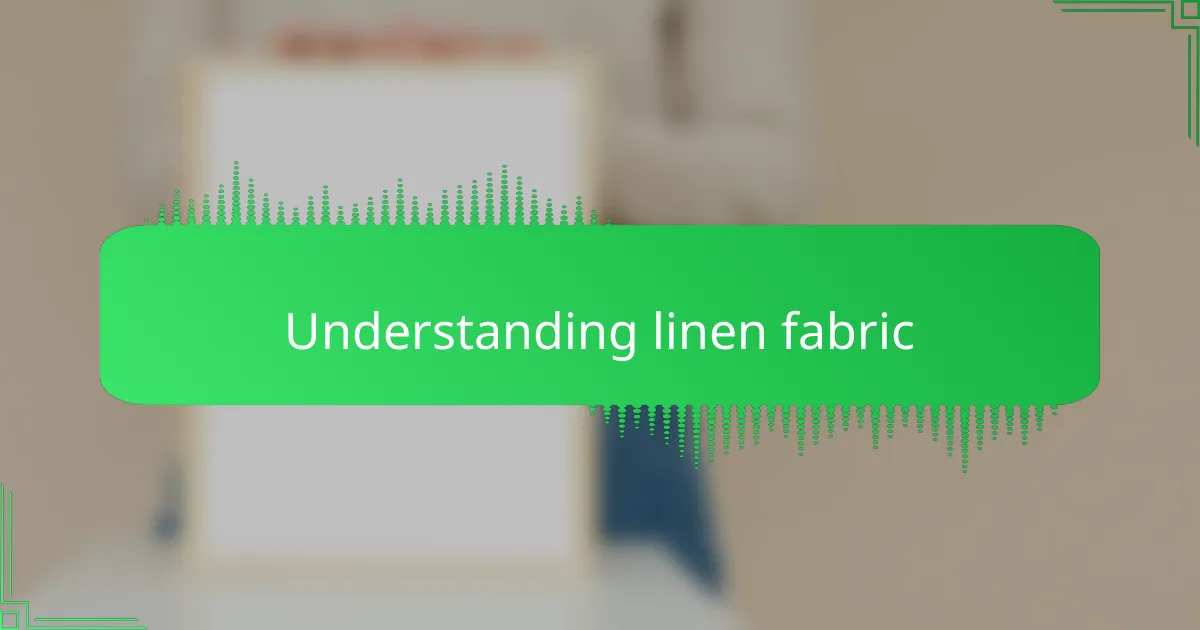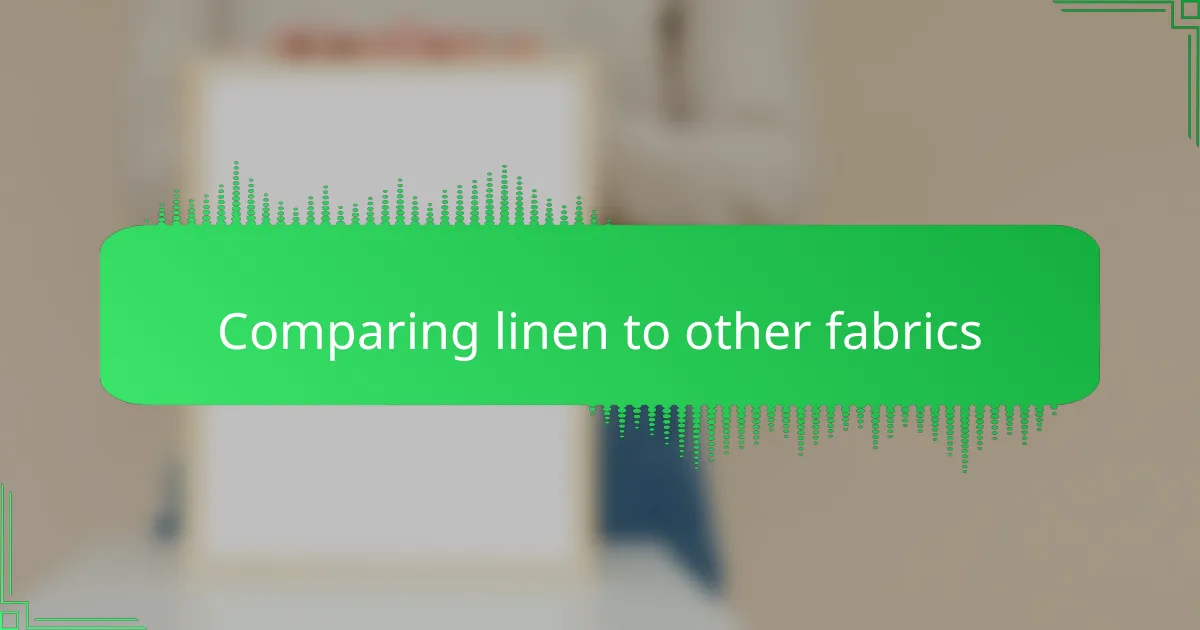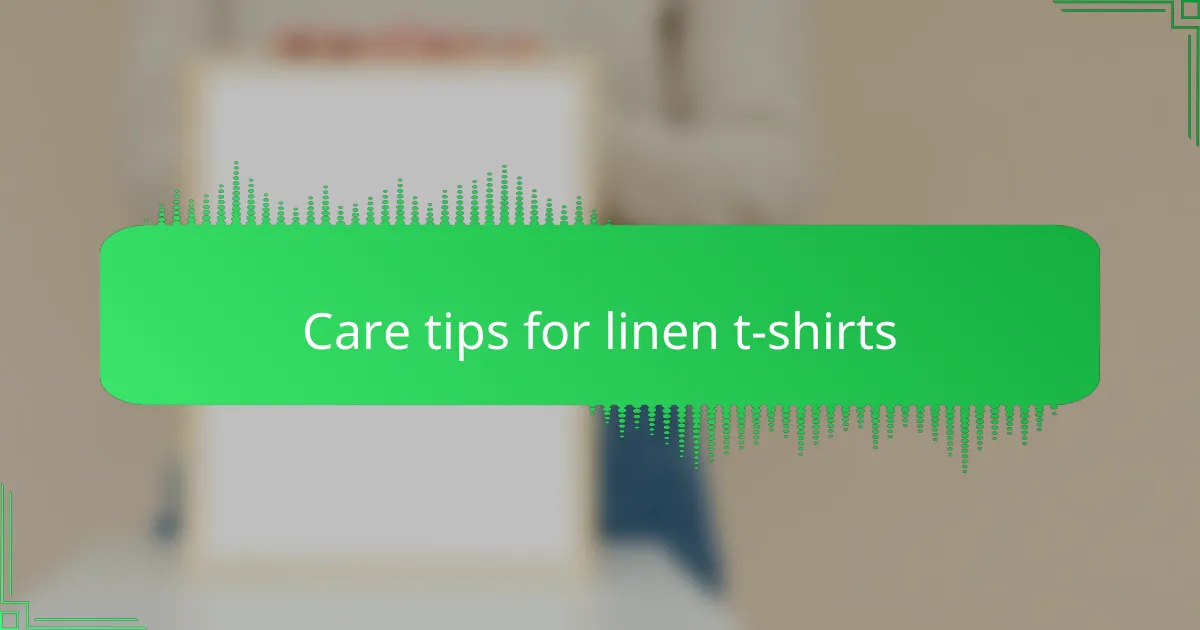Key takeaways
- Linen fabric is breathable and moisture-wicking, making it comfortable for hot weather.
- It becomes softer with each wash, enhancing its durability and character over time.
- When designing with linen, opt for simple cuts and lighter colors to highlight its unique texture.
- Caring for linen involves cold washing, air drying, and light ironing to maintain its charm and shape.

Understanding linen fabric
Linen fabric has always fascinated me with its natural texture and breathability. When I first discovered linen t-shirts, I immediately noticed how the fabric feels cool and refreshing against the skin, especially during hot weather. It’s a material that speaks of comfort and simplicity in a way that cotton often can’t match.
From my experience, linen is made from the fibers of the flax plant, giving it a unique, slightly rough texture that softens beautifully over time. Here’s what I’ve learned about linen fabric in relation to t-shirts:
- Highly breathable, allowing air to circulate and keep you cool
- Naturally moisture-wicking, which helps manage sweat better than many fabrics
- Durable and gets softer with each wash, preventing that stiff, uncomfortable feel
- Has a distinct texture that adds character and a laid-back aesthetic to t-shirts
- Tends to wrinkle easily, which some may see as part of its casual charm
- Eco-friendly, as flax requires less water and pesticides compared to cotton
Knowing these details truly changed how I view linen t-shirts—not just as clothing but as a fabric with personality and thoughtful design potential.

Benefits of linen in t-shirts
One of the biggest benefits I’ve noticed with linen t-shirts is how effortlessly they keep me cool. Have you ever worn something on a hot day and just felt trapped inside your own clothes? Linen breathes in a way that feels like a gentle breeze against your skin, making those sweaty afternoons much more bearable.
I also appreciate how linen naturally handles moisture without feeling clammy. When I’m out and about, especially during summer, my linen tees seem to manage sweat better than my usual cotton ones. It’s a subtle but game-changing comfort that makes a big difference over time.
Another perk I’ve come to enjoy is how linen softens with every wash without losing its strength. Unlike some fabrics that wear out or get thin, my linen t-shirts have this durable quality that ages like a fine wine, becoming more comfortable and characterful each time I wear them. Have you experienced a fabric that feels better the more you use it? That’s the magic of linen for me.

Comparing linen to other fabrics
I’ve found that linen stands out from other fabrics when it comes to breathability and texture. Unlike cotton, which can sometimes feel a bit heavy or clingy, linen offers a cool, crisp feel that makes wearing a t-shirt on a hot day much more comfortable. However, its natural wrinkles can be a bit challenging compared to the smoothness of jersey knit fabrics.
| Fabric | Key Characteristics |
|---|---|
| Linen | Highly breathable, crisp texture, wrinkles easily, lightweight |
| Cotton | Soft, durable, moderate breathability, smooth surface |
| Jersey Knit | Stretchy, smooth, less breathable, retains shape well |
| Polyester | Durable, moisture-wicking, less breathable, resistant to wrinkles |

Designing t-shirts with linen
Designing t-shirts with linen brings a unique texture and breathability that I’ve come to appreciate immensely. When I first incorporated linen into my t-shirt designs, the natural fibers added a subtle, rustic charm that synthetic fabrics just can’t replicate. There’s something comforting about how linen feels against the skin—cool yet durable—that makes the design process more enjoyable.
In my experience, linen’s slightly coarse texture requires thoughtful design choices to highlight its character without overwhelming the wearer. Here are some key considerations I’ve found helpful when working with linen in t-shirt design:
- Choose simple, clean lines to complement linen’s natural texture
- Opt for lighter colors to showcase the fabric’s natural weave
- Avoid overly tight fits; linen works best with relaxed, breathable cuts
- Consider pre-washing the fabric to prevent excessive shrinkage
- Incorporate minimalistic prints or embroidery to enhance, not mask, the linen feel

Care tips for linen t-shirts
Taking care of linen t-shirts is quite a rewarding experience once you get the hang of it. I learned early on that washing them in cold water and using a gentle cycle preserves the fabric’s strength and softness. Have you ever tossed a favorite shirt in the washer only to find it shrunk or lost its charm? Linen t-shirts deserve that little extra care to keep their unique texture alive.
Drying linen t-shirts also taught me a valuable lesson: skip the dryer whenever possible. I usually air-dry mine by laying them flat or hanging them on a padded hanger. This method prevents unwanted wrinkles and helps maintain the shape better. Plus, there’s something satisfying about seeing the fabric naturally soften and air out in the breeze.
Ironing linen can feel intimidating, but it doesn’t have to be a chore. I prefer to iron my shirts while they’re still slightly damp, which smooths out the wrinkles without flattening the fabric’s character. If you ask me, those gentle creases are part of linen’s charm—they tell the story of wear and comfort. Would you agree that a perfectly crisp linen shirt can look a bit stiff? For me, it’s those relaxed folds that add personality.

Personal experience with linen t-shirts
I’ve always associated linen with a crisp, summer-ready vibe, but wearing linen t-shirts showed me a different side of this fabric—comfort paired with breathability. Linen’s natural texture gives the shirt an effortless look, though I noticed it wrinkles more easily than cotton, which initially caught me off guard. Still, that lived-in feel grew on me, adding character to my casual outfits.
| Feature | Linen T-Shirts |
|---|---|
| Comfort | Lightweight and breathable, excellent for warm weather. |
| Appearance | Natural texture with a slightly rustic look; wrinkles easily. |
| Durability | Strong natural fibers that become softer over time but may require gentle care. |
| Maintenance | Needs careful washing to avoid shrinkage and frequent ironing if a crisp look is desired. |

Styling ideas for linen t-shirts
Linen t-shirts offer such a unique texture and breathability that I like pairing them with casual yet polished pieces. For example, I often style a crisp white linen tee with tailored shorts or slim-fit chinos—it instantly elevates the look without trying too hard. I’ve found that keeping accessories minimal really lets the natural fabric shine through.
Another go-to for me is layering a linen t-shirt under a light blazer, which brings a relaxed sophistication perfect for warmer days. It’s surprising how this simple combo shifts a basic tee into something I feel confident wearing out for both work and social events. The ease and versatility of linen keep me coming back to it season after season.
| Styling Option | Why It Works |
|---|---|
| Linen T-shirt + Tailored Shorts | Balances casual comfort with a clean, put-together appearance |
| Linen T-shirt + Slim-fit Chinos | Adds structure while maintaining breathability and ease |
| Linen T-shirt + Light Blazer | Creates a smart-casual look suitable for multiple occasions |
| Linen T-shirt Alone | Showcases the natural texture and keeps you cool in hot weather |
